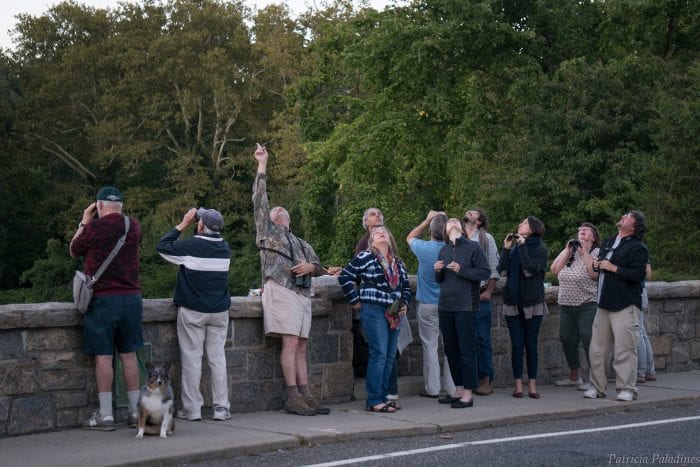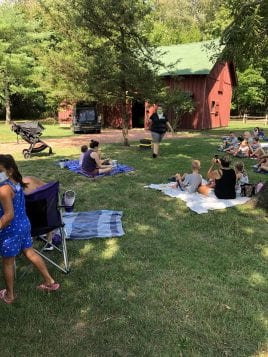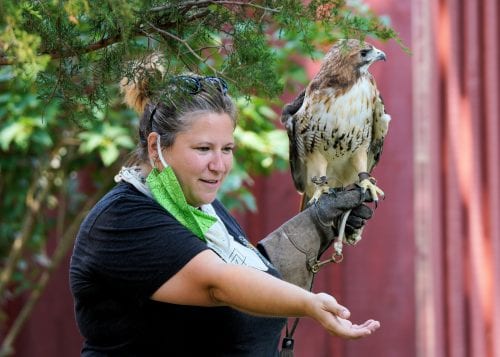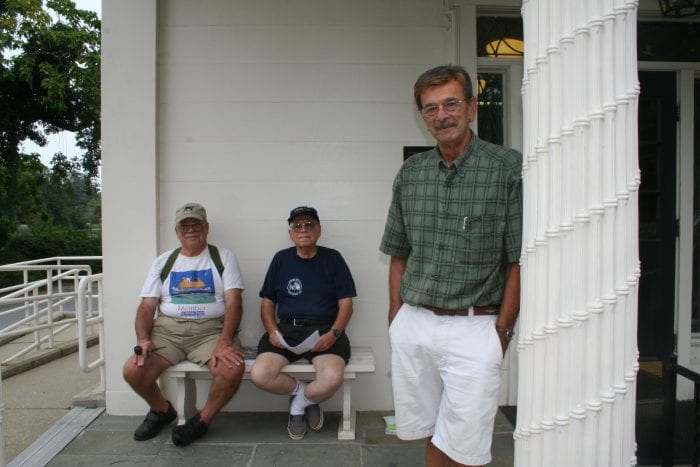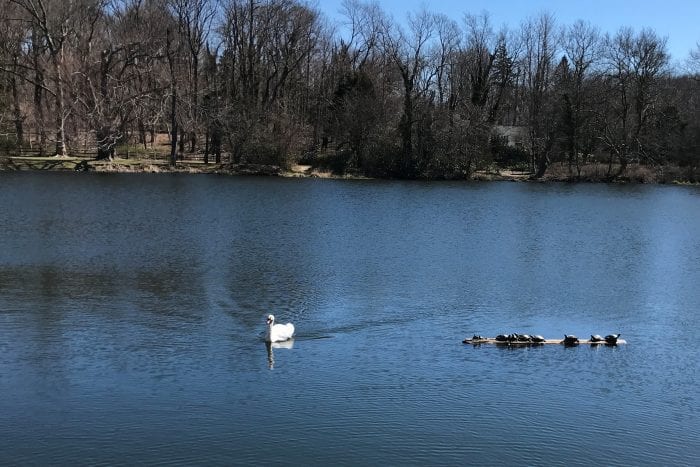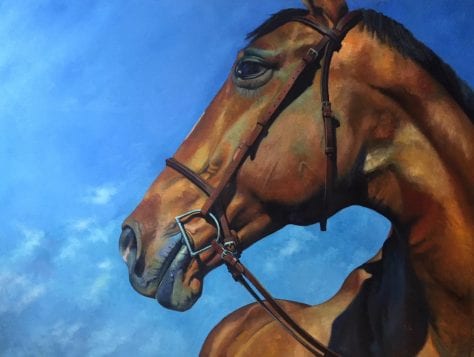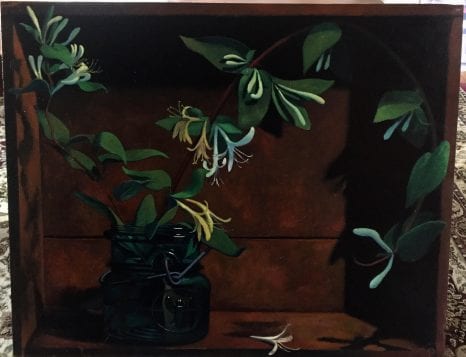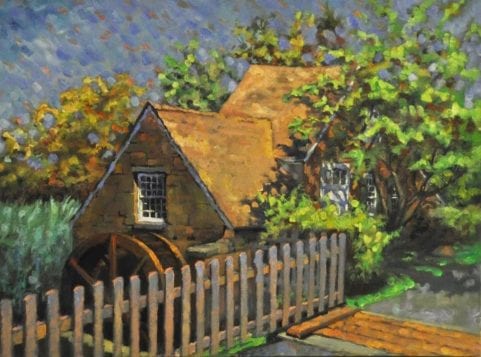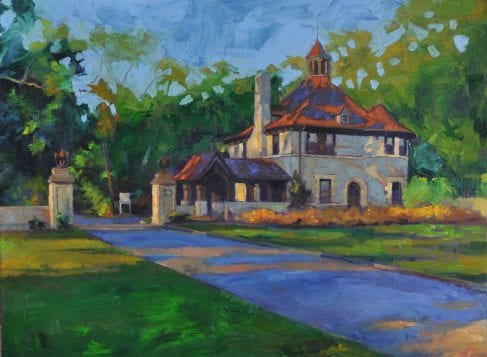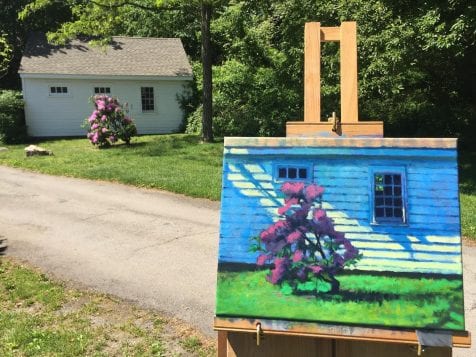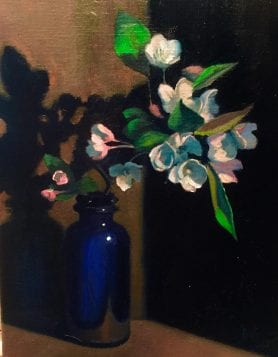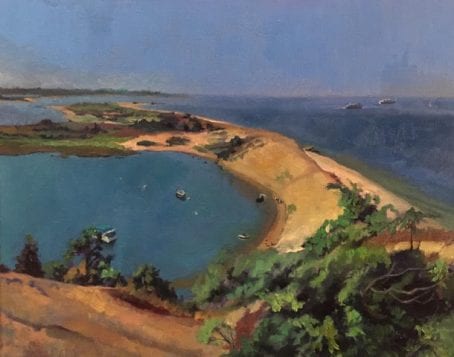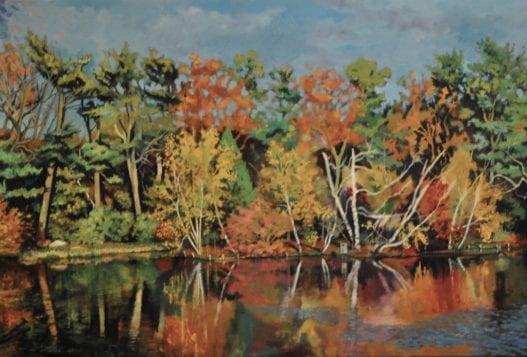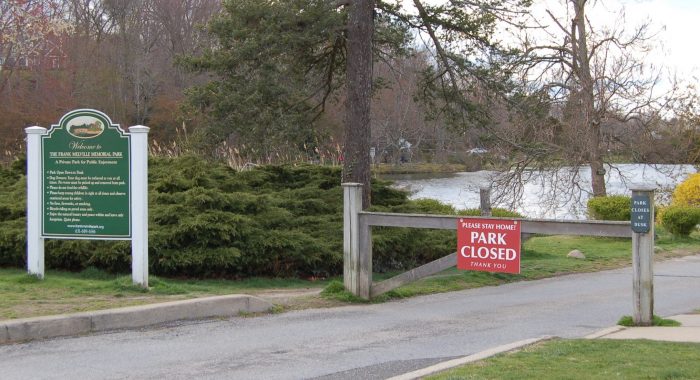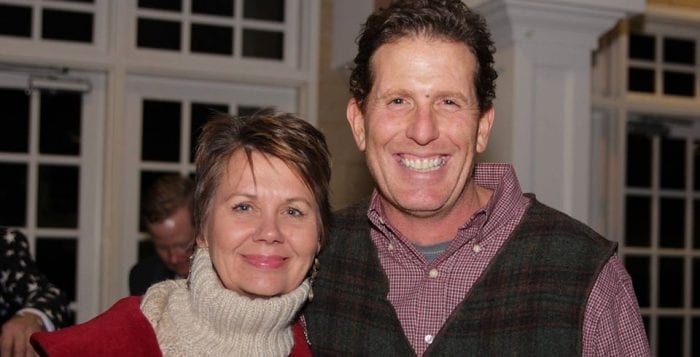Four Harbors Audubon Society kicks off its annual Stone Bridge Nighthawk Watch at Frank Melville Memorial Park, 1 Old Field Road, Setauket on Thursday, Aug. 27 from 5:30 p.m. to dusk through Oct. 6. Volunteers most welcome. Take part in a census which is used to estimate Common Nighthawk migratory numbers each year and to better understand nighthawk population trends. Visit www.4has.org for further details.
Frank Melville Memorial Park
Sweetbriar Animals Visit Families at Frank Melville Memorial Park
The folks from Sweetbriar Nature Center in Smithtown stopped by Frank Melville Memorial Park in Setauket Aug. 11 to give local families the chance to meet some of their animals.
Socially distanced on blankets by the park’s Red Barn children, parents and grandparents had the chance to see birds, a baby squirrel and more up close.
Sweetbriar is home to hundreds of animals that the center employees and volunteers nurse back to health.
Three Village Organizations Find Ways to Connect with Community Despite Pandemic
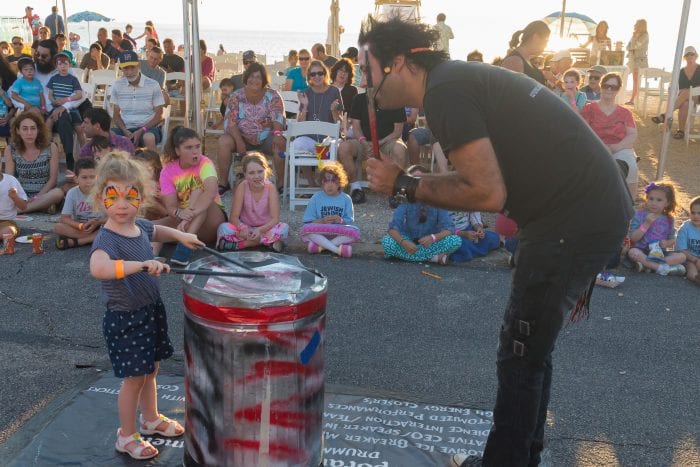
Starting with the annual Memorial Day Parade down Main Street and Route 25A, the Three Village area is normally filled with activities all summer long. While many annual favorites were canceled this year due to the coronavirus, some event organizers are striving to stay connected with residents.

Jay Veronko, post commander of Veterans of Foreign Wars East Setauket Post 3054, said the Memorial Day Parade is usually the group’s biggest event that they host each year. This year’s parade was canceled due to COVID-19.
“I’m not sure of when the last time it was canceled for reasons other than severe weather,” he said.
Veronko said the event means more than simply memorializing former local soldiers who lost their lives in combat overseas or honoring living veterans.
“The parade also serves as a source of local pride in our way of life — the community getting together and coming out and celebrating life and the beginning of summer, as well as getting many diverse groups together to march and let the community know about them and what they stand for or do,” he said. “For the fire departments, it’s a way for the community to cheer them on for doing a great volunteer job and for the departments to display their pride and commitment to serving the community they protect.”
The post commander said many older post members are hesitant to socialize due to fear of getting COVID-19 and are not visiting the post for social interaction, something he said may not be good for physical and emotional well-being. Veronko said while the future may not be clear, the post doors and the members are there for each other.
“The VFW of Setauket will be there for the veterans who need help or want to gather in the comradeship of arms,” he said.
Gloria Rocchio, president of The Ward Melville Heritage Organization, said there have been no in-person events at the Educational & Cultural Center since the mandatory shutdowns. While events currently can be held inside with 50 people or less, WMHO, like many organizations, had to furlough a few employees, and they currently would not have enough people to work on events even if they could be held as usual. The Discovery Wetlands Cruise, which takes participants on a trip through West Meadow Creek, has been suspended for 2020, and the WMHO also decided not to hold its summer music series this year.
While it’s still a couple of months away, the organization has already canceled Walk for Beauty, which is normally held every October to raise money for breast cancer research. Rocchio said many expressed concerns about those who are battling cancer, who may be immunocompromised, attending such an event. As for the future, she said they are waiting for the updates to state guidelines.
Despite the cancellations, the WMHO president said residents have not forgotten the Stony Brook Village Center.
“We get people on the Village Green at night,” she said. “They sit there with their families usually, some might be two people, some are four people. They do social distancing, and they bring food, some even play ball at the lower part. They feel it’s a nice place to watch the sunset.”
She said residents have also noticed people taking advantage of the view more so than in previous years. To continue connecting with the community, WMHO is also offering virtual classes from the wetlands.
“We’re trying to reinvent ourselves,” Rocchio said.
Lise Hintze, Bates House manager at Frank Melville Memorial Park, said many of their usual events, including their outdoor concerts, had to be canceled this summer, but other activities have been able to take place again. She said the size of the park allows for proper social distance for various classes such as yoga, meditation and tai chi where participants have been wearing masks.
“We can continue with our community and come together, because we have the Bates House and parks grounds that are perfect for what they need with those classes,” Hintze said.
Missing this year will also be the Jewish Summer Festival at West Meadow Beach, which Village Chabad in East Setauket hosts in August. The event also didn’t take place last year due to the grand opening of its new center in June 2020. Despite the lack of in-person events, Rabbi Motti Grossbaum said the center has been trying to maintain a sense of community and connection with virtual classes and events. He said while many have said they appreciate the virtual options, the Chabad staff is looking forward to seeing everyone in person in the future.
“There’s nothing that can replace face-to-face and in-person connections,” Grossbaum said. “A community is all about interaction, sharing, schmoozing, kids playing and enjoying friendships in real life.”
Three Village Residents Remember Hap Barnes
Harold J. Barnes, better known as Hap, died July 8 from complications of chronic obstructive pulmonary disease. He was 84 years old.
“Our community has lost an icon.”
— Robert Reuter
Barnes was a long-serving trustee of Frank Melville Memorial Foundation and for many years was building and grounds manager of Frank Melville Memorial Park where he oversaw all maintenance and improvement projects.
“Our community has lost an icon,” said FMMF president Robert Reuter.
The foundation president shared fond memories of the park manager.
“Nothing made Hap Barnes happier than discovering otters in the park or wood ducks checking out nesting boxes he provided,” Reuter said. “Hap was an ardent conservationist, a skilled craftsman who made split bamboo fly rods, and to regular visitors, a friend and the familiar face of Frank Melville Park. Proud, but humble and soft spoken, Hap quietly and effectively managed the park and its myriad tasks as if his own. Turtle caught in the mill wheel? He knew how to safely free the turtle and the wheel.”
Three Village Historical Society historian, Beverly Tyler, knew Barnes since at least the 1970s, and in the past worked with him on
the park.
“Hap maintained a daily, sometimes hourly presence in the park and the sanctuary as well,” Tyler said. “There was no one who was more dedicated to the park and its use and preservation, yet Hap always had a low-key presence with a no-nonsense attitude as well. I will especially miss his calm and reasoned approach to every subject we discussed, especially when I was president of the park. I didn’t always agree with Hap but his counsel was always appreciated and often the best way to go.”
There was no one who was more dedicated to the park and its use and preservation, yet Hap always had a low-key presence with a no-nonsense attitude as well.”
— Beverly Tyler
Town of Brookhaven historian, Barbara Russell, remembered him fondly. She and Barnes started on the FMMF board at the same time.
“We grew to understand the Melville gift of the park together,” she said. “Whenever we met, I was greeted with that shy smile and ‘How ya doin’?’ I especially loved the times someone would walk by us and tell Hap a type of bird or duck they had spotted. He was always interested but rarely surprised as his eye was sharp. I feel I am one of many who will miss his presence in the Three Villages.”
According to a post on the Three Village Historical Society website, Barnes was also involved with the society and took on the responsibility of building and grounds when the society acquired the Bayles-Swezey House.
“We could always rely on him whether it was a large or small project or repair,” the post read. “He always made sure that the electric candles were placed in all the windows of the society’s history center and that a lit tree graced the field for the holidays.”
The society remembered him, too, for helping with traffic and various tasks at events. He also led community parades with his vintage cars. In 2000, he received the society’s Gayle Becher Memorial Award which honors volunteers whose work consists of repeated and regular loyal support.
In a Sept. 13, 2007, Village Times Herald article, Barnes spoke of his admiration of the area.
“We are very lucky to have the Three Village area,” he said. “If we didn’t have this I don’t think I would be on the Island anymore.”
Barnes is survived by his wife, Cynthia, five children, 12 grandchildren and two great-grandchildren. A memorial service is planned to be held in the Frank Melville Memorial Park in early September.
An extended obituary with more of Barnes’ accomplishments will be published in a future issue of The Village Times Herald.
Three Village Historian Pays Tribute to Setauket Park
By Beverly C. Tyler
The intersection of Main Street and Old Field Road in Setauket marks the entrance to the Frank Melville Memorial Park and Sanctuary. The horseshoe-shaped park, completed in 1937, includes extensive plantings, a simulated grist mill, a magnificent view of Conscience Bay and the cottage of the last Setauket miller Everett Hawkins. From the park, there is an entrance to the Frank Melville Memorial Foundation Sanctuary grounds with its extensive nature paths.
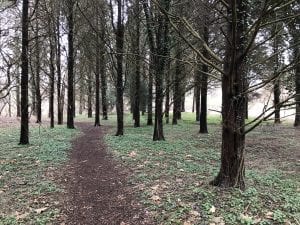
Just after dawn, the Setauket Mill Pond shimmers with morning mist and reflects the early morning sky. Walking along the path in the Frank Melville Memorial Park, the only sounds, except for the occasional car going by, are the birds in the trees and the ducks in the pond. They contrast with the greens, browns and grays of early morning. The contemplative surroundings start the day with the beauty of God’s creation and give perspective to the rest of the day.
I walk the park almost every day. I often stop at one or another of the many benches that line the park and face the lower mill pond. From that perspective, I see what I don’t take in while walking.
At first, the pond surface is like glass reflecting the bare brown trees, their branches forming interlacing patterns against the clear blue sky. Then a gentle breeze turns the pond to silver, moving it with patterns of dark and light. I notice walkers strolling along the path, their bright jacket colors contrasting with the brown shades of old gnarled black birch, white birch and evergreens. One variety of the rhododendrons along the path shows a few beginning buds. The forsythia, the park’s first spring color, is already showing yellow blooms. The dark evergreens, planted almost 80 years ago as mature trees, add vertical splendor climbing skyward.
As I walk, I hear the background sounds of water flowing over the mill dam and into the bay. A pair of mallards glides slowly across the pond occasionally dipping their beaks into the water. Suddenly a mallard glides down to the pond, his wings flapping to slow him down and his feet striking the pond and creating a spray of water. The trumpet calls of geese announce flight as they fly over the Old Field Road bridge, then across the mill dam and into Conscience Bay.
Almost every day I watch a swan glide slowly under the bridge and into the lower pond. Within a few minutes, he suddenly rises just above the water and with wings slapping the surface of the pond, creating a staccato of sound, flies to the north end of the pond near the island and then glides around the lower pond exercising his authority over ducks and geese.
Last month, my wife and I spent an early spring afternoon in the park and sanctuary. We walked into the park past the Setauket Post Office with its Greek Revival columns topped by corn cob capitals. Spring colors were just beginning to emerge along the one-third mile path around the lower mill pond. Together we turned off the horseshoe path and walked past the red barn and the new fencing that marks the entrance to the park sanctuary. We chose one of the middle paths that led into the woods and we were suddenly surprised by a grove of conifers between the path and the Bates House parking lot. There is almost no undergrowth at this time of year and with several trees and bushes removed or cut back the evergreens look spectacular. We continued along the wood chip paths and were delighted by the looks of the bare trees, shrubs and evergreens surrounding us and with the smell of red cedar as we walked.
This is a wonderful time of year to be in the park and especially to wander along the sanctuary pathways. It is impossible to get lost here as all the pathways are circular and you end up at either the red barn at the park or the Bates House at the end of Bates Road. It is also easy to stay a safe distance from other walkers, especially in the sanctuary.
The area around the Setauket Millpond was a center of commerce for the community from the time it was settled in 1655 until early in the 20th century. It is easy to imagine almost any time in Setauket history while in the park. Looking out over the mill dam, Conscience Bay reflects the 8,000 years the Native Americans lived here before the English settlers came to Setauket. The mill tells the story of the farmer grinding grain in the 1700s. The recently restored red barn was originally made from World War One barracks buildings at Camp Upton in Yaphank. The stable is a reminder of the white horse “Smokey” from the 1950s who would always come to the fence for half an apple. The stone bridge relates how an immigrant’s great-grandson, Ward Melville, came to Setauket and gave us an image of the countryside of rural England and Europe with a park and sanctuary.
Beverly C. Tyler is a Three Village Historical Society historian and author of books available from the society at 93 North Country Road, Setauket. For more information, call 631-751-3730 or visit www.tvhs.org.
Artist of the Month: Dino Rinaldi
By Irene Ruddock
After spending his childhood in Port Jefferson, artist Dino Rinaldi studied art at the University of South Florida. Upon graduating, he exercised his artistic creativity by pursuing a career in advertising as an illustrator and sales representative. While also creating television commercials, he devoted his spare time studying fine art with renowned artists at the Art Students League of New York City. After twenty-five years of intense study, Rinaldi moved to Setauket. While living on a nature preserve with his wife and daughter, he is happy to devote himself to drawing and painting.
Were you interested in art as a child?
From an early age I was attracted to art. I drew as a teen and some of my best pieces were created on desktops in high school. Boy, I would love to see some of them now! But what impressed me the most was my Italian grandfather’s pastel portrait and landscapes that sadly disappeared over the years. Both of my parents painted, so the talent apparently has been passed down. However, my mother was the driving influence in me pursuing art throughout my life.
Who influenced you while you studied at the Art Students League?
I started at the League where I discovered a world that I had no idea existed. The talent was intimidating but I was welcomed in by all and turned the intimidation into the goal of being the intimidator! I moved from one teacher to another until I discovered Costa Vavagiakis for figure drawing and Nelson Shanks for color theory, learning techniques that nobody had taught me before.
How did you transition from the advertising world to full time painting?
I noticed people were expendable in that business. I needed an escape plan and a second career that I could pursue anywhere in the world. While hitting my most lucrative stride, I quit the ad business at age 42 and went back to the art school full time, intensely learning for eight months.
After living in New York, what drew you back to Long Island?
At 48, I met my wife Hazel and at 49 my daughter Lia was born. Not wanting to raise Lia in the city, I returned to my home town area. Having grown up in Belle Terre and finding it magical, we found the artists’ dream setting, Miller’s Cottage in Frank Melville Memorial Park, East Setauket. I still work in the ad business, but now work in the seclusion of my studio.
How does living in a nature preserve impact your painting?
Although I hadn’t taken a course in landscape, I knew the allure and dreamlike beauty of the surrounding area would have to be painted. I watched instructional videos, while applying my previously acquired skills and set out with my easel. I love being outside so landscape painting was a natural progression. Hearing swans taking off on the pond and an owl that likes to say hello around 11 p.m. always makes me smile and gives me inspiration to paint.
Tell us about painting local scenes.
I have painted and drawn the Belle Terre Gates in Port Jefferson many times, loving every stroke and remembering back to my childhood. Painting the cove at the end of Cliff Road also holds some of my fondest memories.
You are also known for your paintings of animals. Do you have many commissions for those?
I have a pretty steady clientele who commission me to draw their horses and dogs. The number of people requesting pencil portraits of a family member is gaining momentum. Relatives, famous musicians, artists, and celebrities are among the most requested.
How would you describe your style of painting?
I feel I have yet to hit my stride on one subject are or even one style, but continue to grow and hone my skills with the goal of creating something each painting better than the last one.
You exhibit many beautiful still life paintings in a box. How did this genre come about?
While living in SoHo, I took a walk to Houston Street where people were selling goods. I suddenly saw an old box with a wonderful patina. I was told it was from the 1800’s and “very rare.” After much haggling, we settled on $10. I told the man I was going to paint a still life in the box and paint so many that I would turn the $10 purchase to $10,000. I ended up selling the first one for at the Art Students League for $600. Only $9,400 to go! Since then, I have painted close to 100 objects in the box and the amount must be close to $100,000 in sales.
Since you don’t often enter shows or work with a gallery, how do you seek out opportunities to sell your work or cultivate a collector base?
When it comes to selling my work I found a worldwide audience through Facebook, Instagram, and Saatchi Art online. I love interacting with my over 4,500 friends from around the globe on Facebook: Dino Rinaldi Art. I also have lawn exhibits outside the cottage in the park where my daughter joins me.
Is your daughter following in your family’s footsteps?
My daughter has begun taking her art seriously, often accompanying me with her pink easel to paint various spots in this stunning park. She has already sold 6 pieces! A fine start indeed!
What qualities does a painting to have to satisfy your standards?
Before setting out to paint, I ask myself “Would it be something I want on my walls?” Another criteria is that it must be a great drawing or painting. If the work fails to meet these two criteria, I put it aside and re-use the canvas. I am my toughest critic.
What advice would you give to your younger self?
If I had a chance I probably tell a younger Dino to focus more on art at an earlier age, save your money for a rainy day so you could escape the city earlier for the peaceful life at Setauket, and to keep my head down longer on my chip shots!
Is there one habit that helps or hinders your creativity?
Determination! I paint and draw as many as a hundred hours a week, working late into the night while listening to music. I learned that when you can do something you love, it is no longer a job but a passion.
What role does art have in society?
I have used my art toward helping charities whenever possible. I began a friendship with Petra Nemcova, a model who lost her fiancé in the tsunami almost a decade ago. I was so moved, I set up an art show at Guava Studios and was able to raise $13,000 toward building a school in Thailand.
That is a wonderful achievement! I have heard that you also give to other charities as well.
I have donated to horse rescues and other animal rescues. I think it is a natural progression to want to help people even as I sometimes struggle to make money; rarely do I question if it is the right move.
What are your future aspirations as an artist?
My goal has been to always to enjoy my life in the fullest manner possible while also being able to spend more time with my wife and daughter. I want to sell enough art to pay the bills and keep me in cadmium red! By continuing to study the old masters, I will someday reach my goal of fame and fortune.
Frank Melville Memorial Park to Close Temporarily Due to Pandemic
Frank Melville Memorial Park in East Setauket will be closed effective Saturday, April 11, until further notice, according to a press release from the Frank Melville Memorial Foundation.
“It is with great sadness that I announce the imminent closure of the Frank Melville Park,” Robert Reuter, FMMF president, wrote. “As a private park, open to the public, it has been our view that we are providing a safe and healthy environment during a very difficult time. That view has changed. The park is relatively small and cannot safely accommodate the great increase in visitors. The reluctance of too many to follow social distancing and park rules is jeopardizing their safety and the safety of the majority who do.”
Reuter said the decision was a difficult one for the foundation to make.
“Thank you to all who have been supporting us and our efforts to keep the park a safe place to visit,” he wrote. “Now it is time to stay home and stay safe.”
The board president thanked the trustees, staff and service providers who have kept the park open and it’s projects on track, and he added the trustees “applaud our community’s essential workers and all those on the front lines of the pandemic response. They are heroes.”
Hintzes Share Their Talents for the Benefit of the Community
By Donna Newman
Lise and Steve Hintze have been caring, contributing, active members of the Three Villages for more than two decades. They are both generous givers, willing to share their energy and talents for the benefit of the community. It is with gratitude that we honor them as 2019 TBR News Media People of the Year.
Residents who frequent the Frank Melville Memorial Park in Setauket may or may not know of the Hintzes’ efforts to keep improving and growing this valuable community venue.

Steve Hintze has been a Frank Melville Memorial Foundation trustee since 2008. He served several terms on the board as secretary. At present, he chairs the Park’s Building and Grounds Committee.
“Steve has brought a firefighter’s grit, an MBA, and a wealth of knowledge of all aspects of building and site design to the role,” said FMMF President Robert Reuter. “He also brings an admirable collection of professional-grade tools, and he’s not afraid to get his hands dirty. Steve is always an absolute pleasure to work with and he knows how to complete a project to the high standard for which the park is known.”
His projects have included park lighting, the mill restoration, which is now in progress, and assisting Eagle Scout candidates with their endeavors for park enhancement.
Lise Hintze was recruited to join the park’s staff in 2011 in the dual role of office manager and director of the Bates House. Regular visitors know her as the friendly face of the Frank Melville Memorial Park. Her finger is always on its pulse, and she is ever on the lookout for potential improvements.
“The quintessential office manager, Lise efficiently handles park business,” Reuter said. “As director of the Bates House, she works with demanding brides and anxious grooms on wedding weekends — and then manages all manner of programs during the week. The full schedule of special events and gatherings keeps her on call, but her thorough planning makes it all look easy. A pioneer in social media reporting, Lise has enabled the park to keep Friends informed via a website.”
Lise Hintze has been described as a “Saint on Earth” and a “Super Hero” by folks who know her but wished to remain anonymous. They see her as “the height of humanity” always ready to help. Her credo: “What does anybody — or any animal — need that I can give them?” It is an attribute reportedly shared by her husband.
Steve Healy, president of the Three Village Historical Society, is happy to add his voice to those impressed with Lise Hintze’s abilities.
“Her work at the Frank Melville Park — between the Bates House and the Grist Mill and the growth in the park has been fabulous,” Healy said. “She synergizes the park with the community, is admired for her efforts and she does a great job taking the park to new levels.”
Lise Hintze does not let her job description limit her. If it’s happening in the park, it’s on her radar. Among her many contributions outside of official duties include the Wind Down Sunday outdoor concerts, begun with Katherine Downs and others and an ambitious schedule of three concerts. The park now offers nine. She has, when needed, instigated wildlife rescues. When drug abuse cropped up in the park a few years ago, she took a pragmatic stance and turned a potential security issue into an educational opportunity.
Suffolk County Legislator Kara Hahn (D-Setauket) lauded — and also joined in — that effort.
“Lise has a keen eye for what’s needed in the area,” Hahn said. “The opiate group she helped create in the fall of 2017 brought in speakers and provided a place for parents and students to openly and without judgment discuss the opioid crisis they were witnessing firsthand. It was a critical step for our community.”
The creation of this parent group was most likely the impetus for the Three Village school district’s hiring of a dedicated drug and alcohol abuse counselor, who began serving students and their families the following fall.
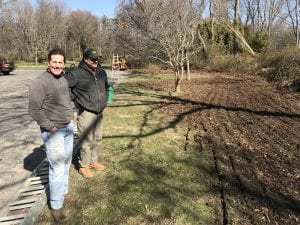
These efforts alone would suffice to warrant community kudos, but there’s more.
Steve Hintze is still heavily involved with the Three Village Historical Society. A past president, he is currently the organization’s grants administrator and is busy gathering the resources to reconstruct the historic Dominick-Crawford Barn on TVHS property in Setauket.
Sandy White, office manager at TVHS had nothing but praise for her former boss.
“Steve was the president when I started working at TVHS. He hired me,” White said. “And to this day he is always there to help — willing to do anything. He’s working now with Steve Healy on the grants for the barn and comes into the office as often as he can. Willing to help anyone with everything, Steve tries to make a difference in everything he does.”
Healy and Hintze, who knew each other as firefighters in New York City before they became active in Three Village nonprofits, apparently share many of the same values. Healy has great respect for his colleague’s vast knowledge and willingness to share it.
“Steve is one of the people I have on speed dial,” Healy said. “When I call I know I’ll get a ‘Yes.’”
“If there’s ever a problem, he doesn’t just give me his input, he’ll roll up his sleeves and get involved in the solution. He’s a special breed with excellent leadership skills and creative ideas. The TVHS is blessed to get someone of his caliber and work ethic.”
Hahn completely agrees.
“Steve Hintze is a pillar of the community and a local hero,” Hahn said. “He contributes so much in real and tangible ways. His calming presence is valuable. He knows how to deal with people, how to motivate them, and how to find solutions, and he is always willing to do what’s necessary.”
There is general consensus with Reuter’s final assessment of these two exceptional individuals.
“They are remarkably modest people and would insist that what they do is nothing special,” Reuter said. “But they are, in fact – something special.”
Your Turn: Plastic netting disaster averted
By Patrice Domeischel
What could have been a plastic trash catastrophe for a Canada goose instead resulted in a happy ending, thanks to the efforts of Anita Jo Lago and Rob Trezza.
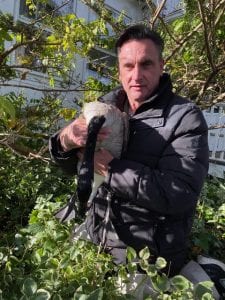
Birders on a Four Harbors Audubon Society walk at Frank Melville Memorial Park in Setauket on Nov. 9 encountered the goose in distress, actively attempting to free itself of plastic netting that had encircled its head and body. The goose managed to remove some netting but was unable to disentangle itself from the remainder encircling its neck and face.
Lago, a park volunteer at Frank Melville, and Trezza, park security, were called in to assess the situation, and promptly went to work. The goose was captured, relieved of the netting and released.
“We really did get it when necessary,” commented Lago. “Its flight was hindered as it was getting away from a cygnet going after it. It took flight but landed happenstance. It landed on the road, Lake Street, because flight was compromised due to the netting holding its jaw and head. When Rob got closer, he saw the goose desperately trying to free itself by banging its head, many times, on the ground. So we got there in time.”
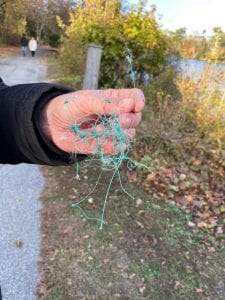 A disaster averted, the goose was able to fly off, a bit stressed and tired from its efforts, but in good condition.
A disaster averted, the goose was able to fly off, a bit stressed and tired from its efforts, but in good condition.
All too often birds and animals suffer the consequences created by our use of single-use plastic. Wildlife can become entangled in discarded plastic, wire or string resulting in injury or death. Even plastic that is responsibly disposed of finds its way into our waters and litters our beaches. Be proactive, protect wildlife and the environment, and reduce or eliminate altogether your use of single-use plastic.
Patrice Domeischel is a member of the Four Harbors Audubon Society.
Take part in the annual nighthawk census in Setauket
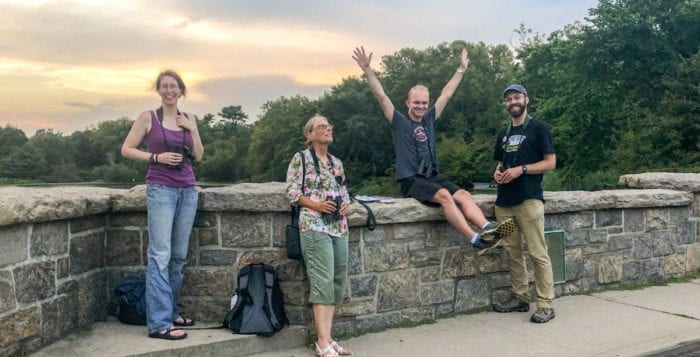
Calling all bird lovers!
Migration has begun! Join Four Harbors Audubon Society at Frank Melville Memorial Park’s Stone Bridge to witness the exciting annual migration of the most beloved members of the nightjar family — the common nighthawk. Migration might be any or all days through early October. Join them from 5:30 p.m. until dusk as they conduct the third annual nighthawk census, and enjoy the show! The Stone Bridge is located at One Old Field Road, Setauket. For more information, email [email protected].


